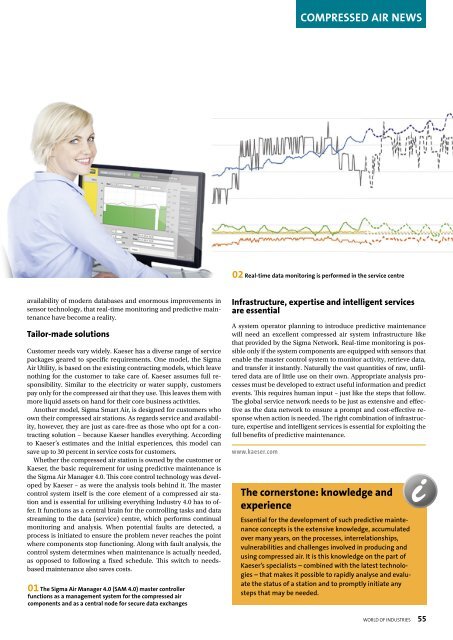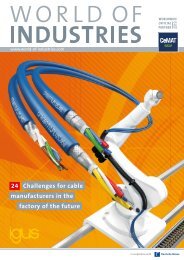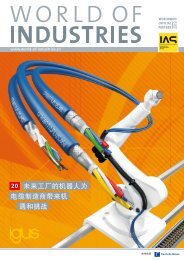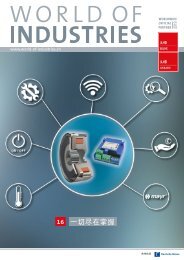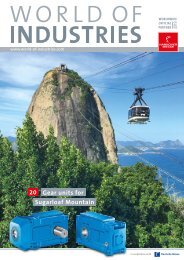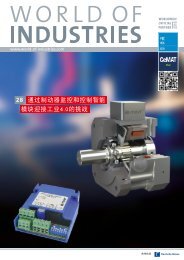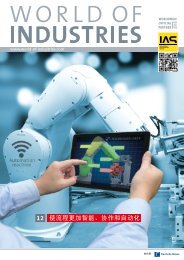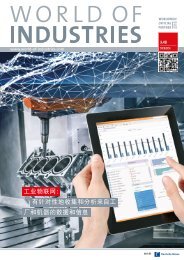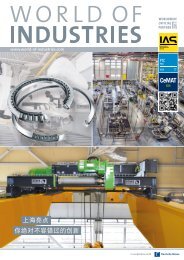world of industries 3/2017 (EN)
world of industries 3/2017 (EN)
world of industries 3/2017 (EN)
- TAGS
- world
- industries
Create successful ePaper yourself
Turn your PDF publications into a flip-book with our unique Google optimized e-Paper software.
02 Real-time data monitoring is performed in the service centre<br />
availability <strong>of</strong> modern databases and enormous improvements in<br />
sensor technology, that real-time monitoring and predictive maintenance<br />
have become a reality.<br />
Tailor-made solutions<br />
Customer needs vary widely. Kaeser has a diverse range <strong>of</strong> service<br />
packages geared to specific requirements. One model, the Sigma<br />
Air Utility, is based on the existing contracting models, which leave<br />
nothing for the customer to take care <strong>of</strong>. Kaeser assumes full responsibility.<br />
Similar to the electricity or water supply, customers<br />
pay only for the compressed air that they use. This leaves them with<br />
more liquid assets on hand for their core business activities.<br />
Another model, Sigma Smart Air, is designed for customers who<br />
own their compressed air stations. As regards service and availability,<br />
however, they are just as care-free as those who opt for a contracting<br />
solution – because Kaeser handles everything. According<br />
to Kaeser’s estimates and the initial experiences, this model can<br />
save up to 30 percent in service costs for customers.<br />
Whether the compressed air station is owned by the customer or<br />
Kaeser, the basic requirement for using predictive maintenance is<br />
the Sigma Air Manager 4.0. This core control technology was developed<br />
by Kaeser – as were the analysis tools behind it. The master<br />
control system itself is the core element <strong>of</strong> a compressed air station<br />
and is essential for utilising everything Industry 4.0 has to <strong>of</strong>fer.<br />
It functions as a central brain for the controlling tasks and data<br />
streaming to the data (service) centre, which performs continual<br />
monitoring and analysis. When potential faults are detected, a<br />
process is initiated to ensure the problem never reaches the point<br />
where components stop functioning. Along with fault analysis, the<br />
control system determines when maintenance is actually needed,<br />
as opposed to following a fixed schedule. This switch to needsbased<br />
maintenance also saves costs.<br />
01 The Sigma Air Manager 4.0 (SAM 4.0) master controller<br />
functions as a management system for the compressed air<br />
components and as a central node for secure data exchanges<br />
Infrastructure, expertise and intelligent services<br />
are essential<br />
A system operator planning to introduce predictive maintenance<br />
will need an excellent compressed air system infrastructure like<br />
that provided by the Sigma Network. Real-time monitoring is possible<br />
only if the system components are equipped with sensors that<br />
enable the master control system to monitor activity, retrieve data,<br />
and transfer it instantly. Naturally the vast quantities <strong>of</strong> raw, unfiltered<br />
data are <strong>of</strong> little use on their own. Appropriate analysis processes<br />
must be developed to extract useful information and predict<br />
events. This requires human input – just like the steps that follow.<br />
The global service network needs to be just as extensive and effective<br />
as the data network to ensure a prompt and cost-effective response<br />
when action is needed. The right combination <strong>of</strong> infrastructure,<br />
expertise and intelligent services is essential for exploiting the<br />
full benefits <strong>of</strong> predictive maintenance.<br />
www.kaeser.com<br />
The cornerstone: knowledge and<br />
experience<br />
Essential for the development <strong>of</strong> such predictive maintenance<br />
concepts is the extensive knowledge, accumulated<br />
over many years, on the processes, interrelationships,<br />
vulnerabilities and challenges involved in producing and<br />
using compressed air. It is this knowledge on the part <strong>of</strong><br />
Kaeser’s specialists – combined with the latest technologies<br />
– that makes it possible to rapidly analyse and evaluate<br />
the status <strong>of</strong> a station and to promptly initiate any<br />
steps that may be needed.<br />
WORLD OF INDUSTRIES 55


